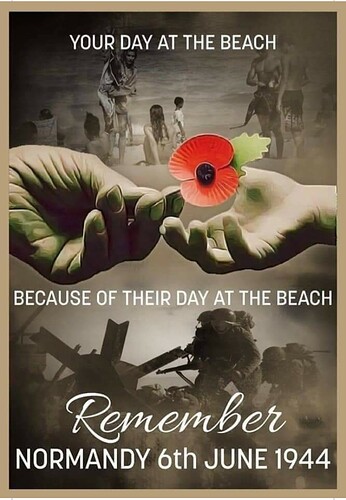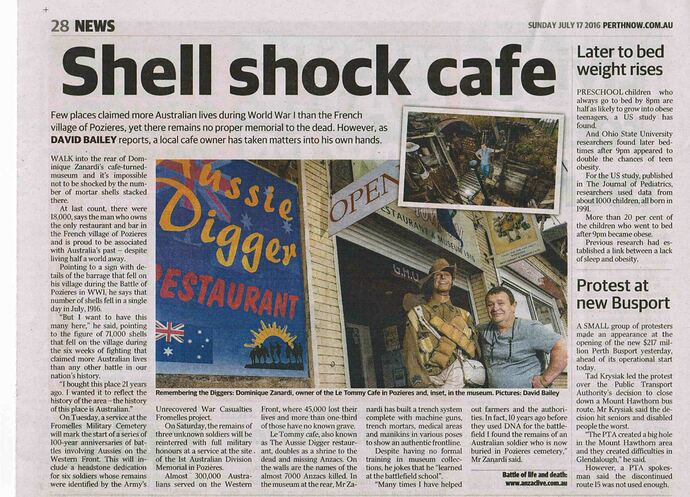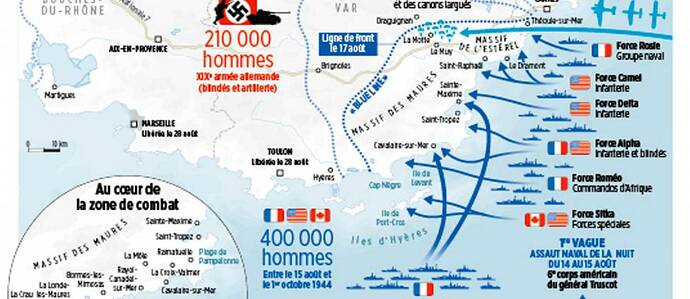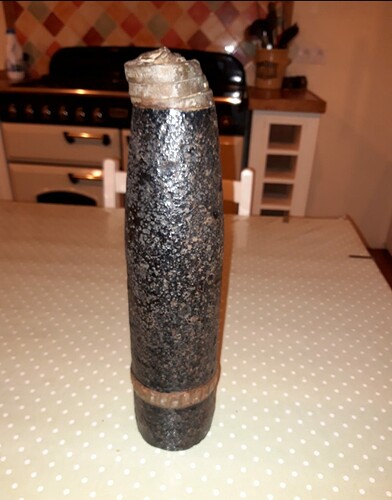I have spent the last 3 years researching my family tree spanning the last 500+ years and of all those years it is the 2 world wars that took so many before their time so that others might live. I didn’t realise just how many of my relatives were killed during those times and no doubt yours too. There are many films and newsreel archives that remind us of D-Day but the reality of it all must have been so much worse.
Spare a thought tomorrow for those brave soles who gave their lives to give us our tomorrow’s.
I agree on D day John, brave men, and all those families who lost loved ones. I think Covid has given us a glimpse on what it must have been like when the World went mad.
That must have been very interesting exercise.
Lest we forget.
??? Not sure I agree. During the periods of the two world wars France had a smaller population of around 41 million, some 70% of current population. And over 2 million people died as a result of the war - soldiers and civilians. The current covid deaths are really modest in comparison.
As for other things - we have food to eat, the country is not occupied by an invading force, and hospital treatment is not just available to a small segment of the population.
Lest we forget is right - world wars are HORRIFIC! Please don’t normalise it.
That’s fair enough Jane but at the very outset Macron was on our screens telling us we were at war. Not a physical invasion but something potentially just as damaging.
I don’t confuse the word “war” with “Wars”. We have wars on waste, on belly bulges, price wars between Aldi and Lidl, and on all sorts of things. The word is commonly used now to mean effort and competition rather than extreme violence using armament.
In 1984 I was spending most of my time doing a renov job on my London flat. A pal in the travel business - a 'ground handling agent ’ - suggested I could have some occasional breaks taking clients on private/bespoke tours. Scenic tours/nice hotels/pay/tips [American tips!]. To do this I had to pass the London Tourist Board Driver/Guide exam.
The syllabus was from Caesar’s invasion to present day. The exam was 70% London. Of that 70%, 70% was St. Paul’s/W-minster Abbey/T of London. Then Oxbridge, Blenheim, Stratford etc. Kings and Queens to memory. Where to take a client for the finest cigars.
The default ex-London day tour is Stonehenge/Salisbury/Bath. This was the day tour question. “Describe your day. Give timing and routing”. My fellow student set off on the A20. Fail
After all this, my first tour was to take an 82nd Airborne Vet to Normandy, for the 40th Aniniversary of D-Day!
Fortunately I was already very familiar with Operation Neptune and associated actions. I’d just never been to the beaches.
That year I did two more Normandy tours and in 1985 the ‘Victory in Europe’ tours, one of which, rather bizarrely, was a 50-seater coach containing The Gilbert and Sullivan Society of Philadelphia touring choir and musicians. One day mili, next day a performance, for a week.
In 1984/5 there were many vets in their 60’s and 70’s. I’d be here all day if I told half the stories of their time in Normandy. I’ll tell just one
This USAAF vet was 35 in 1944. A very experienced pilot and aircraft engineer, he was considered too valuable to fly on combat missions. He trained young pilots and supervised maintenance of a squadron of P52 Mustangs on an airfield in Normandy.
His youngest brother, 20 years old, was serving in this squadron. They went out on a mission but this boy did not come back. Nobody had any idea what had happened to him. My client built himself a ‘Mobilette’ from a bicycle, fueled from drip-trays under the wing-tanks of Mustangs. He toured far and wide trying to discover his brother’s fate. He found nothing.
We had done the beaches element of the tour and were trundling through the countryside. I spotted a US cemetery I’d never seen before. On a whim I turned in. My client looked through the registration book and found his brother’s name!
His name was inscribed on a wall for the missing. It simply said “Lost on a mission over Belgium. Whereabouts unknown.”
This ‘closure’ as we now would say, was a very emotional moment for my client. He said that the whole family back in the US would be happy to find that their boy was not forgotten but commemorated in this way.
My point was Jane, that not since WWII have we had to contend with our loved ones being at risk and dying on such a scale, albeit a different scale to WWII. I was fortunate, my daughter has been in Perth during Covid. Had she been in the UK I would have been scared witless of her working with inadequate PPE. All strata of society has been touched, as in a conflict.
For UK & Commonwealth, at least, if you contact the Commonwealth War Graves Commission, IIRC it used to be a Maidenhead number, they have very good records of who is buried or commemorated where.
This is where I learnt about my great uncle Albert Ellis, who died in WW1 and is buried in The Huts cemetery. The Huts were a grim line of buildings where the wounded were brought, in most cases to die. The paperwork from the CWGC shows me where he’s buried (one day …) and I have a photo of my grandmother in the cemetery which I never understood - I can see the central memorial in the background.
She must have come over to France after the war and I’m guessing that the photo was taken by my grandfather. The gift of the CWGC: over 100 years later I have learnt a little bit more about what my family went through.
Thanks for that, Stella! I’m hoping to visit next week or the week after when the crowds have reduced (and my 2nd vaccination is 3 weeks in the past!)
For anyone who wants to visit, please don’t miss the Mémorial de Caen - describing it as a museum gives entirely the wrong impression. I was stunned and impressed by it and even more by the masses of school parties brought there from all over France as part of their education about their country’s past.
Some great photos…
Indeed. The C.W.G.C. is an institution Britain can be proud of.
On a tour of the Western Front, when I started doing WW1 tours in 2005, I met a Belgian who had just been on a month’s plants and gardening refresher run by the C.W.G.C. All the plants in C.W.G.C. cemeteries are those commonly found in Britain gardens.
Of course, for my U.S.A.A.F. vet, no research in U.S. archives had produced any results so perhaps the U.S. does not have such a comprehensive database. Registries in cemeteries are not compiled into a central archive - or they weren’t in 1985.
Wearing my ‘First Assistant Director’ hat in my day job in photography, I worked for an American advertising photographer based in London.
He was 18 when he came ashore on Omaha beach on day 5 or 6. He said he was amazed to find that, despite heavy shelling by warships offshore, German shelling of the beach, sorties by fighters, smoke, flames… set up on the beach were loudspeaker towers belting out ‘String Of Pearls’, ‘American Patrol’ and other Glen Miller hits!
He was also very impressed when sitting cold, tired, wet and hungry in some muddy French farm lane, a Jeep pulled up. Standing in the Jeep, dressed in a crisp white short-sleeve shirt, complete with trademark pearl handled revolvers, was Gen George Patton
A couple more from 1984/5.
The town of St. Lô has been in my memory since that first tour. I’d never been there until sent to ‘Urgences’ by my ex-M.T. (avoid) some weeks ago.
My 82nd Airborne vet was a simple G.I. He was detailed to the grim task of body-bag duties. He and his buddies were doing this at At Lô when a shell burst in the tree under which they were working.
Wounded. Purple Heart. Home to Lake Placid, Idaho.
Another vet had been a Brigadier I.C. medical teams set up inshore of the dunes once the U.S. had cleared Omaha beach.
As we walked up the dunes off the beach he stopped and said, “I saw my first dead German right here.”
At one of the medical stations he sent an orderly to a nearby farm for water. The man was gone so long another orderly was sent to find out …
The second man did not return, either. The Brigadier asked the infantry platoon Sgt to send a section to the farm to find out what was going on.
They found that the French had cut the throats of both orderlies. The American soldiers killed all the people in the house.
When I told this story to my landlord/lady they were at first very shocked but then sadly said “Collabos…”
I’ve been fortunate enough since 1990 to take or accompany many groups (language trips, field trips, history…) of English school kids’ to lots of WWII sites in Normandy (museums, memorials, cemeteries, D-Day landing beaches etc.), These trips are always very moving and kids like visiting those places and going on “circuits du souvenir” as it makes history alive, relevant, and sometimes even entertaining in an educational way.
I’ve also taken groups to WWI sites, in particular around Albert and Péronne in the Somme department, Picardy (the Thiepval Memorial there is particularly impressive and moving).
About two kms from Thiepval there’s a unique café that’s a favourite among kids and staff, called Le Tommy – Café du souvenir (also B&B), located in a tiny village called Pozières,
There’s also a few “ANZAC” memorials (Australian and New Zealand Army Corps), museums and ANZAC-related “chemins de mémoire” in that area which commemorate the major ANZAC involvement there, particularly at the Battle of Pozières (about which Australian historian Charles Bean wrote: “The Pozières ridge is more densely sown with Australian sacrifice than any other place on earth."). In The Tommy, instead of a beer garden the French owner (who had a British wife/partner the few times I visited) has recreated two trenches (one British and one German) along with a little museum (of sort) with objects collected or found locally.
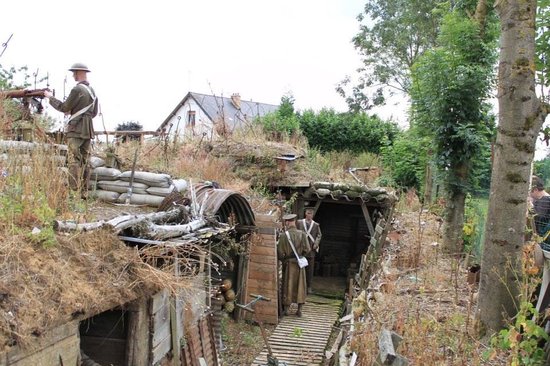
I recommend that caff if you’re ever in the area, it’s an incredible place, very popular with kids and staff alike, and also of course with the many British and Australians/NZ visitors to the area.
Normandy and Northern France are awash with such places, and rightly so.
Now, by contrast, I’ve also taken or accompanied groups to Provence and The Riviera and would have wanted to do the same there, but sadly it’s just not possible. I only wish the Côte d’Azur bothered to remember the key Allies’ invasion of Provence (Operation Dragoon), I wish that Operation Dragoon even had a fraction of the recognition enjoyed (for want of a better term) by Normandy but this key historic episode of WWII is criminally overlooked. You’ll be hard pressed to see any significant trace of it in dpts #13, 83 and 06 and it’s a crying shame. The contrast with Normandy, regardless of the differences between the two débarquements (on many levels) is stark and brutal.
Unlike in Normandy, on the Côte d’Azur there’s been little “effort mémoriel” re the the Allied invasion of Southern France. When you travel down there it feels that “Operation Dragoon” (often called locally “Le débarquement de Provence”) never actually took place, the contrast with Northern France is so weird and unsettling.
This crucial episode of WWII has largely been forgotten. Everybody knows about the Normandy landings but who knows about the Provence one apart from a few history buffs and the locals down there?
There are historic and political reasons for that (explained in the Le Point article below, to do with De Gaulle) and also, today, more prosaic financial reasons for this “oversight".
On the Normandy coastline, you cannot drive a couple of miles without stumbling upon a memorial, a museum, a monument, a physical reminder of the allied invasion. By contrast, on the Provence coast, nothing, apart from tiny monuments squeezed between a giant car-park and a campsite.
Part of my family lives there, between Grimaud and Nice, and one my aunts lives 500 yards from one of the main beaches the Allied (mostly Americans and French) used for landing, La Nartelle Beach in Ste-Maxime. See this map:
Well, again, hardly anything there to commemorate that massive allied invasion involving over 400,000 men and massive logistical operations (over 500 warships, which had to come from much further away that the ones from England to Normandy, from French Algeria, from Sicily etc.). My older relatives down there told me that veterans and historians’ associations there have repeatedly tried to get something going, to at least have some sort of decent memorial but nope, they came a cropper, no mayor or MP was interested.
There is little political will to sort of replicate what they’ve done in Normandy so it’s become a forgotten event. No sites, no commemoration “industry”, no veterans’ tours and so on.
Yet the potential is there. But the coast is so built up now that there isn’t much space left to build on the coast, between the villas, the hotels, the campsites etc. and the prices are sky-high. Land is now at a premium, very expensive and they prefer to sell any available bit of land to property developers and private people.
Unlike in Normandy, anniversaries and commemorations down there are local and low-key.
[The ‘forgotten’ invasion of southern France
Friday August 15th will mark the 70th anniversary of the allied landings on the beaches of southern of France. Anita Rieu-Sicart looks back at a crucial operation, dubbed “The Forgotten Campaign”, that is often overlooked because of the Normandy landings.
[…]
Everyone has June 6, 1944 seared in their collective memory, and the landings on the Normandy Beaches of Juno, Omaha, Utah, Gold, but Operation Dragoon (originally Anvil), as it was code named, tends to get overlooked – the forgotten campaign.](https://www.thelocal.fr/20140808/allied-invasion-provence-forgotten-campaign/)
This Le Point article below addresses the issue, well worth a read:
Provence, le Débarquement oublié
[…]
La “Provence” est le parent très pauvre de notre mémoire réservée aux fondus de la res militaria . “C’est choquant, déplore Paul Gaujac, un des rares historiens à avoir détaillé l’événement, surtout que les résistants de la brigade des Maures, à qui cette fois on avait fait confiance, ont bien plus qu’en Normandie secondé les soldats qui débarquaient.”
Our first french house was in Normandy bought in 1992.
In 1994 there were massive commemorations for the 50th anniversary of D-Day which were amazing. During renovations of our house I unearthed a WW2 shell which an expert tells me is British, thankfully spent, I still have it.
To help with our daughters A level history i took her and 3 friends on a weekend tour of the cemeteries, beaches etc.
One of her friends, Katti, was German and we took time to visit a German war cemetery. To walk by the graves of soles no more than children and the same age as the 4 girls was without doubt a very sobering occasion and a reminder that no matter who you are and where you come from we are all equals but sadly many in today’s world think otherwise.
WW2 shell found in the garden of our Normandy house in 1994 some 50 years after it was fired in anger.
When researching my family history I learnt that my grandfathers nephew was killed in battle barely 4 miles from our house, the area of the Suisse Normande is now so beautiful and tranquil but like many areas of France hold dark and thankfully now distant memories of unimaginable horrendous times.
